Paxton Brick and Tile Works, Hutton, Scottish Borders.
c.1830 – Erected and then new kilns erected mid-1880’s by James Stevenson. – source
1837 – Charles Cuthbertson – Brickmaker, Paxton Brick Shades, Berwickshire. page 297 – 1837.
Below – 17/06/1854 – Newcastle Journal – To be let. On the Estate of Paxton, Parish of Hutton, and Shire Berwick, Paxton Brick and Tile Works, together with the houses and garden, about 12 acres of land. The houses, pug mill, kilns, &c. have recently been thoroughly repaired. The drying sheds are new and extensive. The lands consist of about 7 1/2 acres arable, the remainder being Pasture and for the excavation clay. Mr James Catanach, gardener, Paxton Lodge, will show the premises, and point out the boundaries of the lands, with the condition of let. Offers to be lodged with Mr A. F. Gardiner, Sunnyside Milne Graden Coldstream, on or before the 30th June current. Sunniside Milne Graden, May 31, 1854.

Below – 23/02/1855 – Newcastle Courant – To Builders. To let. the buildings of 3 ovens or fire brick kilns at Paxton Tileworks near Berwick. Plans and specifications seen on the works. Tenders received on or before 2nd March by Mr Gardiner, Sunniside, Milne Graden, Coldstream.

1856 – 1858 – ScotlandsPlaces – Paxton Brick and Tile Works. A manufactory on the Paxton Estate on which are made bricks & tiles for the use of the adjacent district.
Property belonging to David M Home Esq. Tiles for drains are also made & much used.
Below – 1857 – Paxton Brick and Tile Works.

Below – 1857 – Paxton Brick and Tile Works.
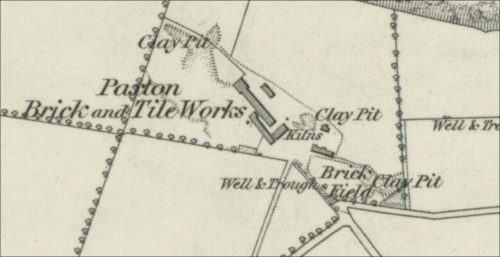
Below – 21/08/1858 – Berwick Journal – On Saturday the 14th inst., the workmen of Mr Walter Linn, of Paxton tile-works, held their annual kettle in Mr Richardson’s, the Cross Inn. Mr Robert Baird was called to the chair, being the oldest workman at the manufacture, having faithfully served successively three preceding masters previous to the present undaunted and persevering tenant. The vice-chair was occupied by Mr Wm. Sherlaw, well known for his excellent qualities. After ample justice had been done to the lords of the finny tribe, and the cloth being removed, the usual loyal toasts were given. The health of their worthy master, and that of his brother, the resident, kind, and indulgent manager was drunk in a flowing bumper, which was nobly responded to by Mr Walter Linn in a neat and humorous speech, appropriate to such an occasion. The company’s health was alternately drunk and responded to, and the remainder of the evening spent in the greatest harmony and friendship. Great credit is due to Mr Richardson; the superiority of his liquors, for which he is so greatly famed, gave great satisfaction to the whole company.

1867 – William Linn, Brick and Tile Maker, Paxton.
24/01/1868 – Kelso Chronicle – Marriage – At Paxton Tile Works on 14/01/1868, Mr Thomas Trotter, Shepherds Bush to Agnes Sherlaw daughter of William Sherlaw, Paxton Tileworks.
Below – 02/08/1870 – Berwickshire News and General Advertiser – Large whinstone boulder found in the clay field.
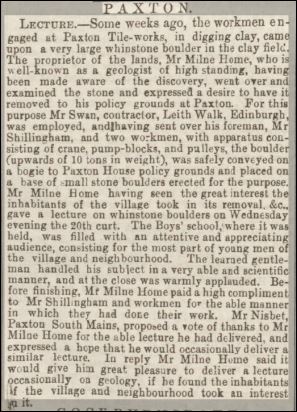
Below – 31/12/1872 – Berwickshire News and General Advertiser – Price list of Paxton Tile Works products.
Paxton Tilework – List of prices of drain pipes, bricks etc from and after 1st Jan. 1873.
2 inch drain pipes. ….. ….. ….. ….. ….. 25s per 1000
3 ” ” ….. ….. ….. ….. ….. 40s “
4 ” ” ….. ….. ….. ….. ….. 60s “
5 ” ” ….. ….. ….. ….. ….. 80s “
6 ” ” ….. ….. ….. ….. ….. 120s “
Common bricks, ….. ….. ….. ….. ….. 35s “
Perforated partition bricks, ….. ….. ….. 35s “
Large-sized do for using on edge, ….. ….. 55s “
Segment tiles for culverts, ….. ….. ….. 65s “
Ridge tiles, ….. ….. ….. ….. ….. 85s “
Roofing tiles, ….. ….. ….. ….. ….. 75s. “
Paxton House, Berwick, 30th December, 1872.
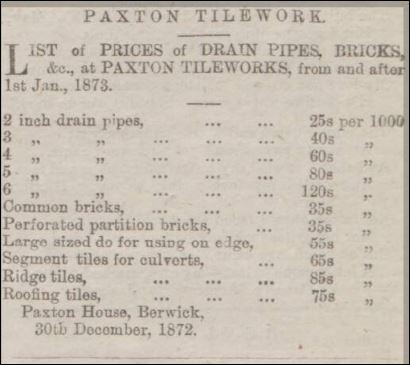
07/06/1875 – The Berwickshire Advertiser – Night Classes for young men. During a short time last winter, an experiment was tried of having a class for young men, beyond school age who were desirous of keeping up the knowledge they had acquired at school. The class was not so successful as it might have been owing partly to the severity of the weather and the want of good previous arrangements to make it known that such a class was to be opened. Nevertheless, the result has been sufficiently encouraging to make it probable that a similar class will be tried again this winter. The teacher notes that the following were in attendance – “R.T Tilemaker, Paxton Tile Works. Distance to school 1 mile. Aged 17. Attendance 19, proportion mensuration.”
Below – 14/11/1876 – Berwickshire News and General Advertiser. Mr Muirhead, Paxton, factor, for the proprietor, Captain Milne Home of Wedderburn.

Below – 30/11/1876 – Paxton Brick and Tile Works for let … The steam engine and brick and tile making machinery are quite new and of the most approved construction. The sales from the works this season amounted to upwards of £800. The clay and tiles made from it are of the finest quality. A new bed of clay averaging 7 feet in thickness with about 2 feet of tirring has been recently discovered lying within 50 yards of the engine house and machinery …
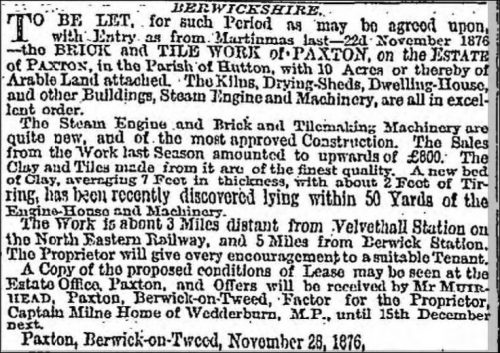
Below – 24/11/1876 – The Berwickshire advertiser – Sale of horses, cattle, implements etc in field of Mr John Ford, Near Paxton Tile Works in the Parish of Hutton and County of Berwick,
On Friday the 1st December Next, at Twelve o’Clock Noon. The following stock, implements &c., belonging to Mr Leonard Thomson, Tile maker, Paxton Tileworks, vis.:-
S T O C K
2 Work Horses, 5 and 8 years old.
1 Harness Mare, 8 ” “
1 Cow in Calf, 4 ” “
2 Stirks in forward condition.
2 Calves, and a Brood Sow and Pigs.
Implements nearly new, 3 Short carts with Wheels; 2 Long Carts; Pair Cart Wheels; 2 Ploughs; scuffler; Pair Harrows; Grubbing Harrow; Metal Roller; Turnip Sowing Machine; Turnip Cutter; Reaper; Metal Pump; Cart and Plough Harness; Rakes; Forks; Sheep Nets; stobs, &c., &c., Also a gig. Ready Money. R. G. Swan, Auctioneer, Dunse, 13th Nov. 1876.

23/12/1879 – Berwickshire News and General Advertiser – Sheriff Criminal Court. Sheriff Dickson. Edward Watson, Clarabad Mill and Leonard Thompson, tile maker, Paxton Tileworks were charged with contravening the Tweed Acts by having on the 17/11/1897 illegally taken a sea trout from the mill lade at Clarabad Mill or with having been found near to said mill lade with intent illegally to take or kill salmon. They pleaded not guilty but after evidence had been led the charge was found proved and each fined 12/6 and £1 7s 1 1/2d of expenses.
06/09/1881 – Berwickshire News and General Advertiser. Eastern Border Horticultural Society. Class 2 – Penstemons – Thomas Thomson, Paxton Tileworks.
Mid 1880’s – James Stevenson was born in 1837 and educated at Greig’s Academy, Perth. He then attended classes in Perth with the artist Aitken Steil from 1852, before becoming assistant to his father, a Perth builder, in 1853. Four years later he moved to Edinburgh where he was articled to William Carmichael. In 1860 he moved to London as an assistant to J & G Girdwood of Pall Mall, where he remained until commencing independent practice in Berwick-upon-Tweed in 1870. He later took his son into partnership. He was admitted LRIBA on 20 March 1911, proposed by H C Charlewood and the Northern Architectural Association. Prior to that time, he had undertaken study tours encompassing Rome, Venice, Florence and elsewhere in Europe. Died after 1923. In the mid-1880’s he built new kilns at the Paxton Brick and Tile Works.
1886 – Thomas Thomson – Brick and Tile Maker, Paxton, Berwickshire.
Below – 1897 – Paxton Brick and Tile Works.
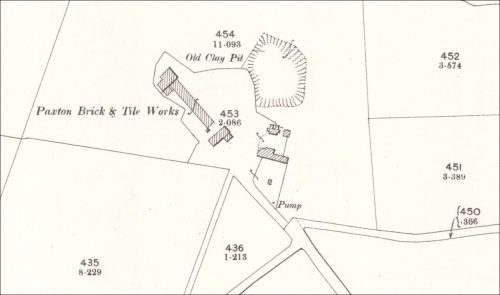
Below – 08/01/1889 – Berwickshire News and General Advertiser – Flowerpot sale, Paxton Tileworks. Thomas Thomson Manager. Pots made by an experienced potter from the Wellington Pottery, Glasgow. Pots for sale include Orchid pots and Seakale pots
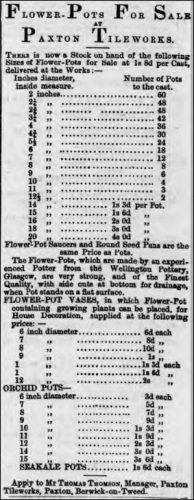
Below – 17/03/1900 – The Scotsman -Paxton Tileworks for sale.
For sale by private offer, at Paxton Tileworks (5 miles from Berwick-on-Tweed).
1 Eight H.P. Vertical steam engine.
1 Metal clay pug mill.
1 Set of clay bruisers and shafting.
1 Drain pipe double-acting machine. Screens and dies, for bricks and pipes and culvert segments.
1 Brick-making machine, dies and cutter.
1 Whitehead pipe machine with Dies 2 to 12 inches.
1 Set dressing rollers (or large drain pipes, Various moulds for pavement, roofing and ridge tiles.
1 Clay waggon and a quantity of iron rolls.
3 Shelving pipe wheelbarrows.
4 Kiln wheelbarrows.
10 Kiln centres for erecting arched roofed kilns.
1 Potters’ wheel and instruments for making flower pots.
1 Turning lathe for ditto.
The bricks composing the square engine chimney, offers to be in slump.
The bricks composing the three tile kilns, offers to be in slump.
This entire shelving, offers to be 100 lineal feet, comprising all the several tiers.
The rafters and tile laths of roof, offers to be by the 100 linear feet of roof.
The whole of the roofing and ridge tiles, offers to be by the 1000.
Written offers to be received for part or the whole of the above by Frank Muirhead, Factor, Paxton, Berwick-on-Tweed, up to the 20th March 1900, but the highest or any offer may not be accepted.
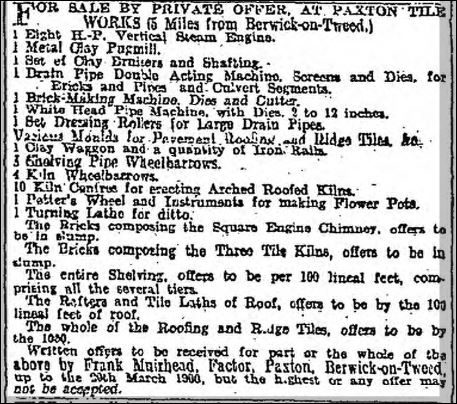
1901 – Directory of Clayworkers -Thomas Thomson, Paxton, Berwick upon Tweed.
1906 – Paxton Brick and Tile Works (marked as disused) – so it is likely that the entries for 1911 below are just using the Paxton Tileworks as an address.
31/08/1909 – Berwickshire News and General Advertiser. Death – At Dacre Court, Morpeth on 24/08/1909, Janet Pilmer, widow of the late Alexander Pringle, late of Paxton and Bothal Tileworks.
15/08/1911 – Berwickshire News and General Advertiser – Paxton County Festival – Horseshow – Class 14 – Prize by Mr T Thorburn, Paxton Tileworks for best foal by any of his horses, colt or filly – M Kirkwood, Ayton.
13/08/1912 – Berwickshire News and General Advertiser – Paxton County Festival – Horseshow – prize by Mr T Thorburn, Paxton Tileworks for the best foal by any of his horses, colt or filly. Filly – D. Cowe. Colt – M.L.Kirkwood
*********************************************
Historic Scotland listing – Category C (S)
The 1830s. Remains of a single-storey, 3-bay, battered, rectangular-plan former brick and tile works kiln block. Squared sandstone rubble to outer elevations; red brick inner linings. Rubble quoins; polychrome dressings to arched openings.
NW (ENTRANCE) ELEVATION: 3 regularly-spaced, round-arched chambers between lean-to buttresses.
NE (SIDE) ELEVATION: blank.
SE (REAR) ELEVATION: blank.
SW (SIDE) ELEVATION: blank.
Roof missing/broken. Trees growing from within 1999.
INTERIOR: brick-lined, barrel-vaulted chambers with small, arched openings at the ground to rear; earth floors.
Thomson’s map, 1821 (not evident). Sharp, Greenwood & Fowler’s map, 1826 (marked as ‘Paxton Tilework’). Ordnance Survey map, 1908 (marked as ‘Paxton Brick & Tile Works – disused’)
Works disused by 1900, ruinous 1999. This is all that remains of Paxton Brick & Tile Works – the early Ordnance Survey map shows a further large, rectangular-plan building to the NW, clay pits to the E and SE and ‘Brick Field’ to the SE. A relatively rare building type, this block is particularly notable for its brick-lined chambers and polychrome dressings. The NMRS photographic records refer to the individual chambers as ‘Newcastle Kilns’. ‘Tile Cottage’, originally associated with the works, is set to the SE.
************************************************************
Below – Newcastle type kiln – Paxton Brick and Tile Works, Paxton, Berwickshire
Source Brick, Tile and Fireclay Industries in Scotland. RCAHMS Publication. Drawing by Graham Douglas 1983.

**********************************************
Below – September 2016 – photographs of Paxton Brick and Tile Works. Not surprisingly due to being located very close to the English / Scottish border, named bricks from both England and Scotland were found forming part of the Kiln structure and lying around the general area of the works. Bricks stamped “Ramsay” and “Cowen” from Newcastle and bricks stamped “PG”(Preston Grange) and “John Grieve, Bankpark Fire Brick Works” (Tranent) were prevalent.
Below – 8 photographs showing the kiln construction and brick burning at kiln mouth.
 .
. 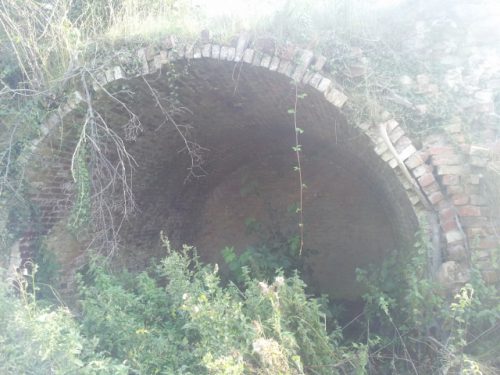
.
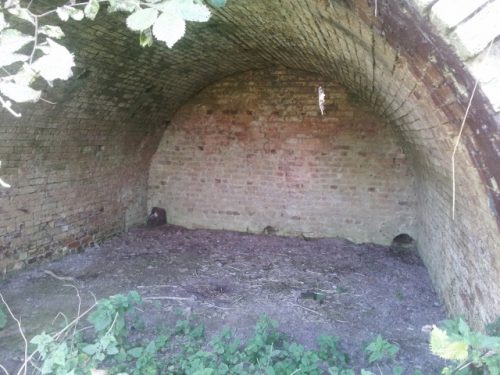 .
. 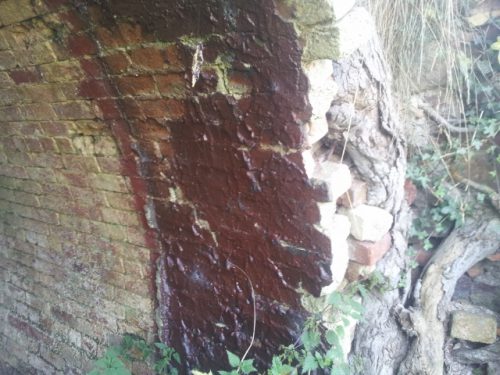
.
 .
. 
.
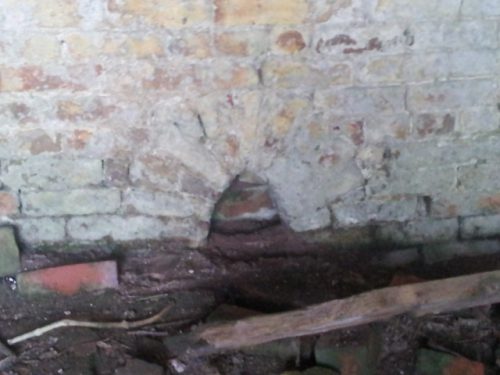 .
. 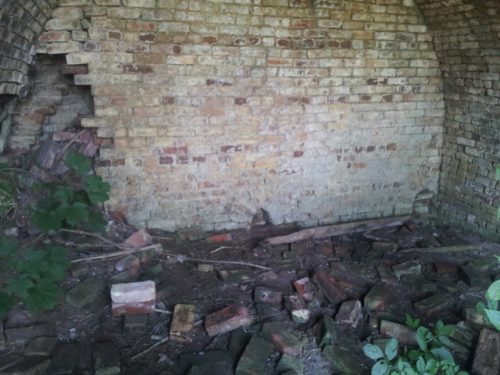
Below – 9 photographs showing side, front and back views of the kilns including close-ups of the sandstone block exterior (including a brick tile embedded in part of the exterior wall)
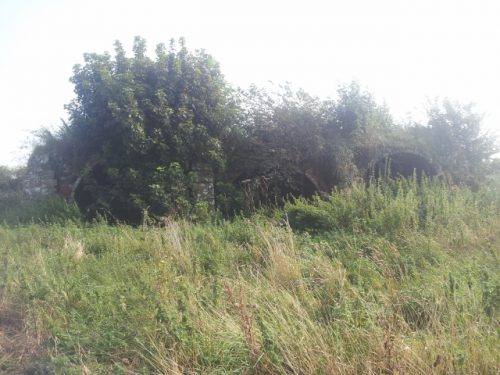 .
. 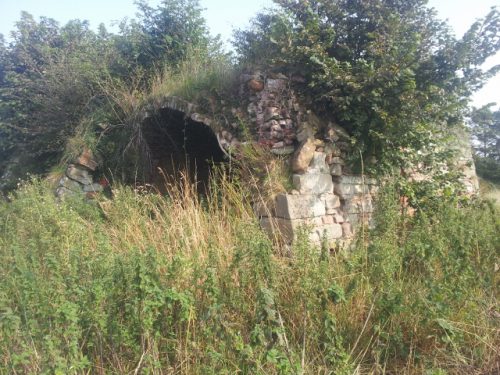
.
 .
. 
.
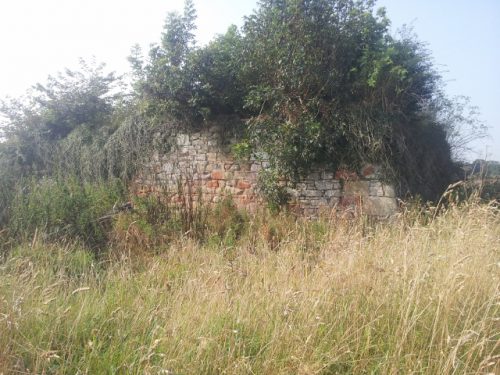 .
. 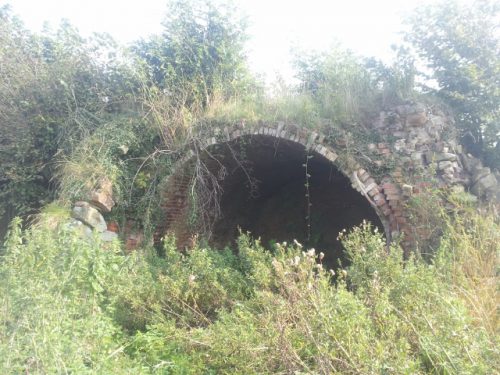
.
 .
. 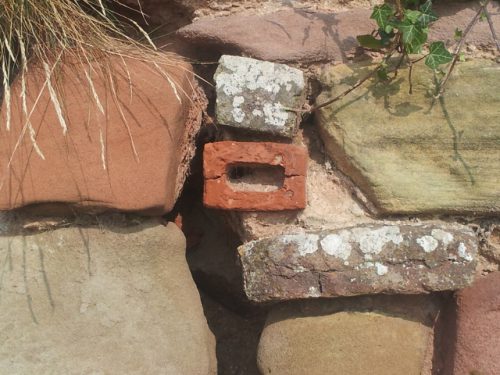
.

Below – photograph 1 was taken from the kiln back towards the public road and shows the probable original access road to the site, to the left of the central hedge.
Photograph 2 shows the field to the North of the kiln which was strewn with broken drainage pipes and bricks etc
Photograph 3 is the reverse view of photograph 1. Taken from the public road and the kilns are situated in the group of shrugs right of middle. The access road is off frame to the right.
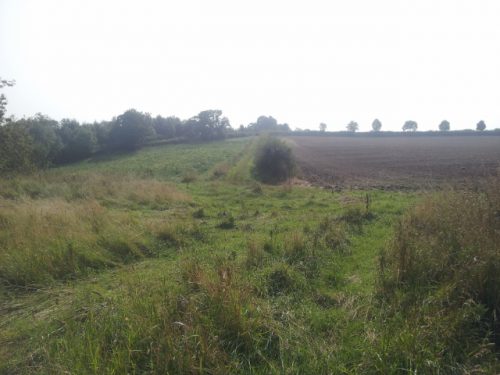
.
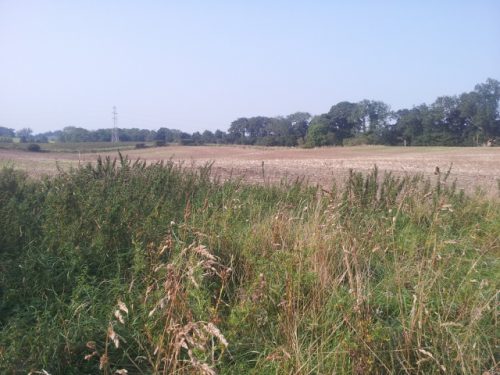
.
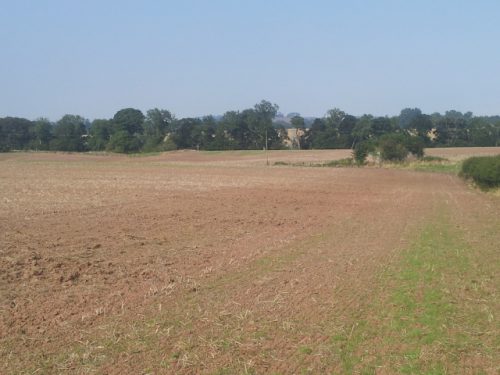 .
.
Below – 3 photographs of buildings in the neighbourhood displaying pantiles and bricks more than likely manufactured at the Paxton Brick and Tile Works.
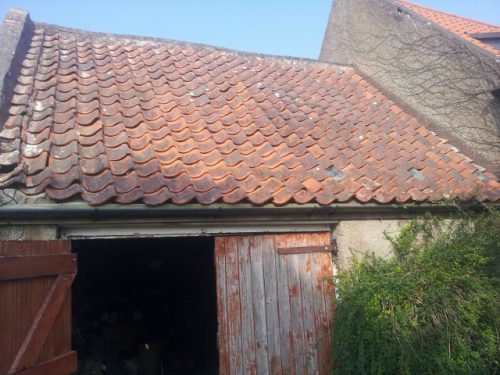
.

.
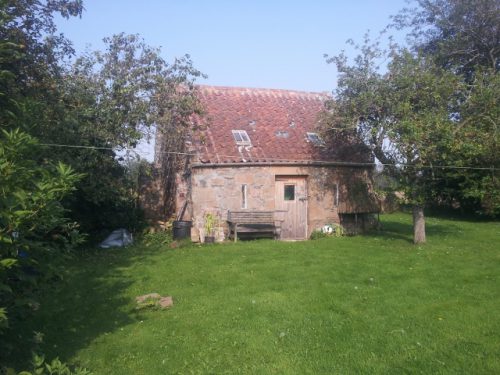
Below – 2016 – Google Satellite map view of Paxton Brick and Tile Works, Scottish Borders.
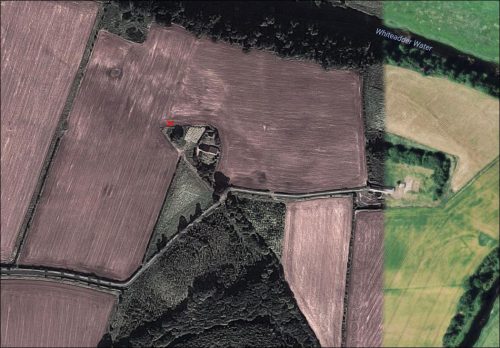
Below – An assortment of products manufactured at or utilised at The Paxton Brick and Tile Works.
Below – An assortment of bricks found at the Paxton Works. Bricks stamped “P.G.” for Preston Grange and bricks stamped “John Grieve, Bankpark, Fire Clay Works” were prevalent. The other bricks in the photos were unstamped.
The brick top left is a blown brick as a result of bad firing in the kiln.
The brick bottom left is a very early brick measuring 8 1/2″ x 4″ or 3 3/4″ x 2″

.
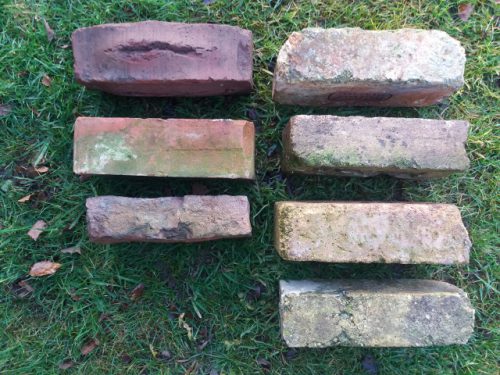
Below – A broken section of drainage tile probably manufactured on-site and measuring 2″ flat bottom, 2 3/4″ wide x 2 3/4″ high.

.
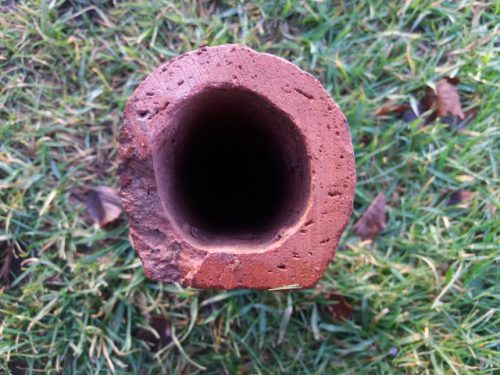
Below – This item appears to be its natural length of 8″. It is 2 1/2″ wide. The hole is 1 1/8″ wide and 1 1/2″ high. The is a ridge that runs along the top of the item on the left photo. I imagine the product consisted of two holes. Not sure what it is meant to be – perhaps a section of segmented drainage tile but there is hardly a noticeable curve on it so it would take many to form a full circle.
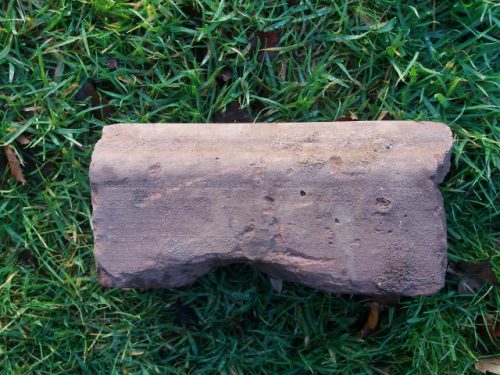
.

Below – These 2 photographs are of a broken section of segmented drain. Up until now, I have only seen this type of drain in Northumbria. However, Paxton Brick and Tile Works is very close to the Northumbrian Border and was possibly worked at once stage in conjunction with the Edrington Brick and Tile Works which were just on the other side of the Whiteadder Water and only a few 100 yards into Northumbria. It appears each section was 7″ wide and of unknown length. It is 2 5/8″ wide and has 10 small holes that would run the length of the section. The holes measure roughly 1/2″ x 1/2″
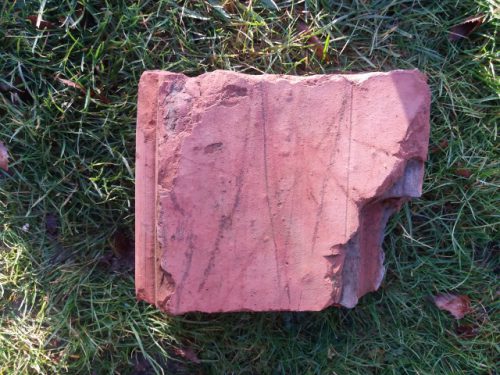
.

Below – This is a connecting ring for 2 drainage tiles. The pipes would be of a smaller diameter to this ring and the ring would be simply placed over the join of the two pipes as it was laid into the drainage trench. This was to stop the ends of the pipes slipping away from each other through time and allowing the soil to trickle into the pipes causing blockages. There was no cement used to join any of these pieces – they were just laid tightly together. The flat bottom is 2″ wide and the ring is 4″ x 4″

.
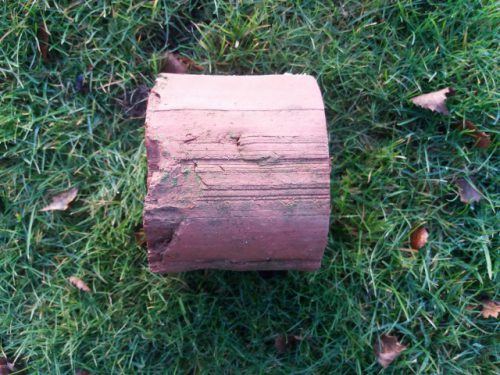
Below – This is some sort of broken air vent or drainage brick. Unknown length by 6″ wide x 3 1/2 ” high. The holes measure 1 1/2″ x 1 3/4″
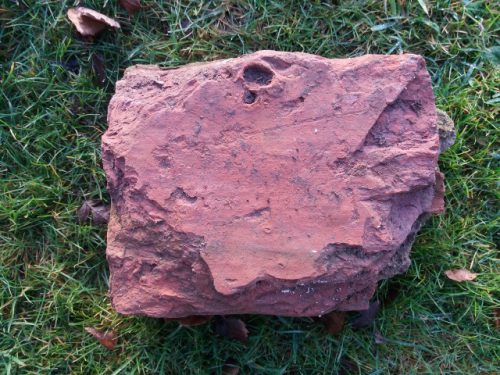
.

Below – Jim McFarlane has forwarded the following photos of a segmented drain/cundy on his farmland at Paxton. It is presumed these were made on site. They are of a different design and shape than the broken segmented drain section above.

.
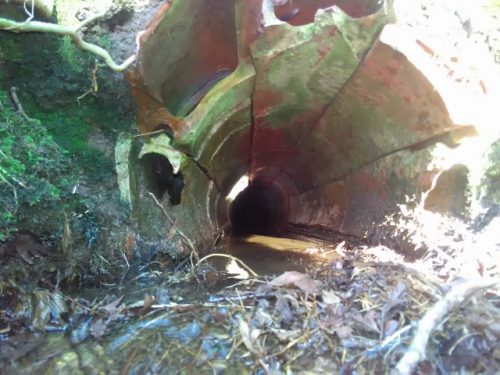
.
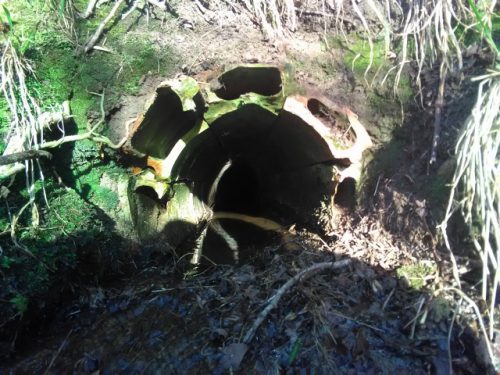
















 .
. 
 .
. 
 .
. 
 .
. 
 .
. 
 .
. 
 .
. 
 .
. 



 .
.


















